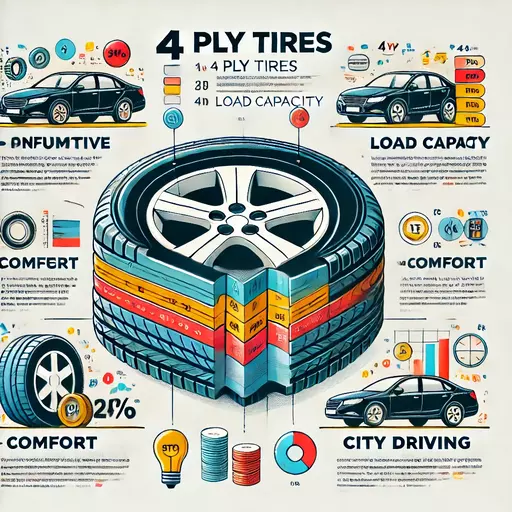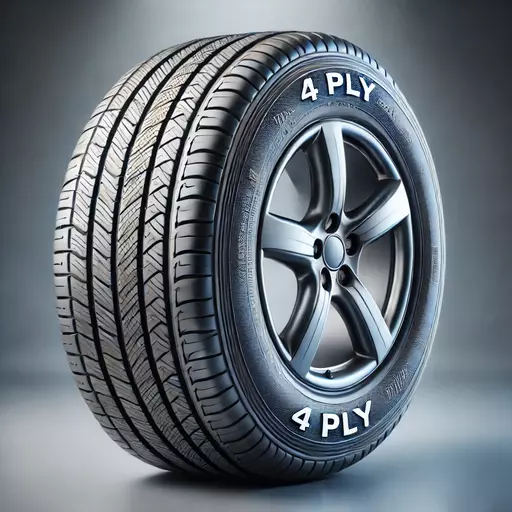Let’s face it: buying new tires can feel as confusing as trying to solve a puzzle without the picture on the box. You hear terms like “ply rating” or “4 ply tires” thrown around, and it may leave you wondering, “What does that even mean for my car?” Don’t worry, you’re not alone, and we’re here to help you unravel this mystery step-by-step.
In this guide, we’ll break down 4 ply tires meaning, explain their advantages and limitations, and help you decide if they fit your driving needs. Whether you’re considering a tire upgrade or simply looking for a better understanding of what’s keeping your car on the road, this guide has got your back.

What Are Ply Ratings, and Why Do They Matter?
Before we dive into 4 Ply Tires Meaning, let’s tackle the concept of a “ply rating.” Ply ratings refer to the layers of material used to construct a tire’s body. In the past, tires were literally made with layers—often cotton or other fibers—that added strength to the tire. The more layers (or “plies”), the stronger and more durable the tire.
Modern tires, however, aren’t constructed quite the same way. Thanks to advances in technology, today’s tires often use fewer physical layers, but materials like steel and polyester are much stronger than the cotton plies of old. Still, the term “ply rating” sticks around as a way of measuring a tire’s strength and load-carrying capacity.
So, when we talk about a 4 Ply Tires Meaning today, we don’t necessarily mean the tire has four literal layers. Instead, we’re referring to the tire’s load-carrying capabilities, equivalent to what a traditional 4 ply tire could handle.
What Does 4 Ply Tires Meaning in Practical Terms?
In practical terms, 4 Ply Tires Meaning are often referred to as “Standard Load” tires. They are designed for everyday use—perfect for city driving, commuting, and lighter vehicles. If you drive a sedan, a compact car, or even a small SUV, 4 ply tires are likely an excellent fit for your needs.
These tires are built for comfort and efficiency. They offer a softer ride, which makes sense if your driving style involves a lot of city miles, neighborhood commutes, or highway driving without the burden of heavy loads. With fewer plies, the tires remain flexible, enhancing comfort by absorbing bumps and providing a smoother ride.
Pros and Cons of 4 Ply Tires
Every type of tire comes with its strengths and limitations, and 4 Ply Tires Meaning are no different. Here are the main pros and cons to consider:
Pros
- Comfortable Ride: The flexibility of 4 ply tires often translates to a more comfortable driving experience. They help absorb minor bumps and vibrations, providing a cushioned feel on city streets.
- Better Fuel Efficiency: Lighter construction means less rolling resistance, which can improve your vehicle’s fuel efficiency.
- Affordable: Typically, 4 ply tires are more affordable than higher-rated alternatives, making them a budget-friendly option for many drivers.
Cons
- Lower Load Capacity: 4 ply tires aren’t designed for heavy loads. If you frequently carry large loads or tow, you might need tires with a higher ply rating, such as 6 or 10 ply.
- Limited Off-Road Capability: If you enjoy taking your vehicle off the beaten path, 4 ply tires might not provide the durability needed for rough terrains, rocks, and other off-road obstacles.
Who Should Consider 4 Ply Tires?
If you use your car mainly for city driving, commuting, or highway travel without carrying heavy loads, 4 Ply Tires Meaning are likely a solid choice. They provide all the comfort and efficiency needed for these conditions without the added cost and stiffness of heavier-rated tires.
On the other hand, if you own a truck, regularly haul cargo, or enjoy off-road adventures, you might want to consider tires with a higher ply rating for added strength and durability.
Comparing 4 Ply Tires to Higher Ply Tires
Let’s break down the difference between 4 ply tires and those with higher ply ratings, such as 6 or 10 ply tires, to help you make an informed decision.
| Ply Rating | Load Capacity | Typical Use | Ride Comfort |
|---|---|---|---|
| 4 Ply | Light (Standard Load) | City driving, commuting | Softer, more comfortable |
| 6 Ply | Medium (Extra Load) | Light trucks, moderate loads | Balanced comfort and strength |
| 10 Ply | Heavy (Load Range E) | Towing, heavy-duty trucks, off-road | Stiffer, less comfortable but durable |
Key Takeaway: The higher the ply rating, the greater the load capacity and durability. However, this often comes at the expense of ride comfort. It’s about finding the right balance based on your driving needs.
How Do Ply Ratings Impact Tread Life and Performance?

One common question is whether ply ratings affect how long a tire will last. The truth is that ply ratings mainly affect load capacity, not necessarily tread life. However, if you’re using a tire outside its intended purpose—like using 4 ply tires for heavy-duty work—you may see faster wear, reduced performance, and potential safety risks.
For regular commuting and city driving, 4 ply tires offer an excellent balance of comfort and tread life, as they’re specifically designed to handle such environments. Regular maintenance, like keeping your tires properly inflated and rotating them on schedule, will help maximize their life.
The Evolution from Bias Ply to Radial Ply
To fully appreciate what “4 ply tires” means today, it’s useful to understand a bit of tire history. Tires used to be made with a construction called “bias ply,” where the layers were laid diagonally across each other. This method resulted in a rigid tire that wasn’t particularly flexible.
With the invention of radial ply tires, which feature layers running radially from bead to bead, tires became much more flexible and durable. Radial ply construction is now the standard for most passenger vehicles, offering improved comfort, stability, and fuel efficiency. So, when we refer to “4 ply” today, we’re typically talking about radial ply tires rated for the same load as a traditional bias ply with four layers.
Choosing the Right Tire for Your Vehicle
If you’re considering new tires, it’s not just about the ply rating. Here are a few other factors to think about:
- Tire Size: Make sure the tire size matches your vehicle’s specifications. You can usually find this information in your car’s manual or on the sidewall of your current tires.
- Tread Depth: Deeper treads offer better grip, particularly in wet or snowy conditions. Consider what kind of driving you do most—if you live in an area with lots of rain or snow, a tire with good tread depth is important.
- Speed Rating: Tires have speed ratings that indicate the maximum speed they can handle safely. Make sure your tire’s speed rating matches your driving habits.
- Load Index: The load index tells you how much weight a tire can carry. It’s crucial to pick tires with the right load index for your vehicle, especially if you regularly carry passengers or cargo.
Real-Life Examples: Are 4 Ply Tires Right for You?
Let’s explore a few scenarios:
- The Daily Commuter: If you’re driving to work, running errands, and sticking mainly to paved roads, 4 ply tires will give you a comfortable ride with better fuel efficiency.
- The Weekend Adventurer: If you drive a truck or an SUV and spend weekends camping or off-roading, consider going up to a 6 or 10 ply tire. These tires are designed to handle the rough conditions that come with leaving paved roads.
- The DIY Home Renovator: If you often haul supplies for projects at home, you might want a higher ply rating to ensure your tires can safely handle the extra weight.
How to Maintain 4 Ply Tires for Long-Term Use
Even if 4 ply tires fit your driving needs perfectly, they still need proper care to perform well and last a long time. Here are a few tips:
- Regularly Check Tire Pressure: Under-inflated tires wear out faster and impact your fuel efficiency. Check your tire pressure monthly.
- Rotate Your Tires: Rotating your tires every 5,000 to 7,000 miles ensures even wear and extends the life of your tires.
- Alignment and Balancing: Keeping your wheels aligned and balanced will help your tires wear evenly and improve your overall ride comfort.
Wrapping Up: Are 4 Ply Tires the Best Fit for You?
Ultimately, the decision to choose 4 ply tires depends on how you use your vehicle. For those who prioritize comfort, affordability, and fuel efficiency in their daily drives, 4 ply tires are a fantastic choice. They’re easy on the wallet, easy on fuel, and offer a comfortable ride for those trips around town or on the highway.
If your driving conditions are more demanding—whether due to heavy loads, towing, or rugged terrain—it might be worth exploring options with a higher ply rating to ensure your tires meet your needs without compromising safety.
Ready to upgrade or replace your tires? Take stock of your driving habits, your vehicle, and your typical road conditions. Choosing the right ply rating will make all the difference in how your car feels on the road.
Got More Questions?
If you’re still not sure about what ply rating is best for you, feel free to reach out to your local tire expert or drop us a comment below. We’re all in this together, and finding the perfect tires doesn’t have to be complicated—sometimes, it just takes a little support from a community that cares.
Frequently Asked Questions (FAQ)
1. What does a 4 ply rating mean?
A 4 ply rating indicates the tire’s load-carrying capability. It doesn’t mean the tire has four literal layers, but instead represents a load capacity similar to what a traditional 4 ply tire could handle. Modern tires are often made with advanced materials that require fewer physical layers.
2. Are 4 ply tires good for off-road use?
4 ply tires are generally not ideal for off-road conditions. They are designed for comfort and efficiency on paved roads. For off-road use, a higher ply rating like 6 or 10 ply is recommended to handle the tougher terrain and provide better durability.
3. Can I tow with 4 ply tires?
Towing with 4 ply tires is not recommended if you’re dealing with heavy loads. These tires are designed for light-duty use. For towing or carrying heavier loads, consider tires with at least a 6 or 10 ply rating.
4. How do I know if 4 ply tires are right for me?
If you use your vehicle for everyday commuting, running errands, and general city or highway driving without carrying heavy loads, 4 ply tires are likely a good fit. They provide a comfortable ride and better fuel efficiency, making them great for standard use.
5. How often should I rotate my 4 ply tires?
To ensure even wear and extend the lifespan of your tires, it’s recommended to rotate your 4 ply tires every 5,000 to 7,000 miles. Regular rotations help maintain balanced wear and keep your ride comfortable.
6. Do 4 ply tires affect fuel efficiency?
Yes, 4 ply tires can positively affect fuel efficiency. Their lighter construction leads to reduced rolling resistance, which can result in better gas mileage compared to heavier tires.
7. What is the difference between 4 ply and 10 ply tires?
The main difference lies in their load capacity and intended use. 4 ply tires are designed for standard load and offer a more comfortable ride, whereas 10 ply tires are built for heavy-duty use, such as towing and off-roading, providing extra strength but with a stiffer ride.